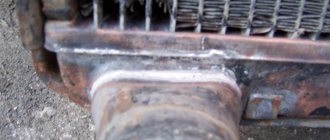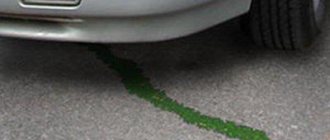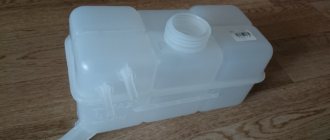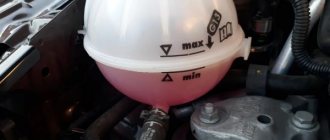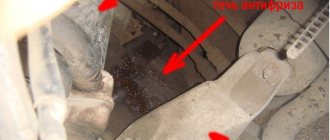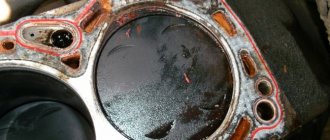A slow decrease in the level of antifreeze in a car’s cooling system is a fairly common problem, especially in cars of domestic manufacturers. Most experienced drivers have an idea where to look for the problem and how to deal with it. But in some situations, even they are not able to understand where the fluid goes from the expansion tank. To learn how to troubleshoot such problems, you need to know all the causes of fluid leaks - obvious and hidden.
Obvious reasons for loss of antifreeze
A drop in the coolant level in the reservoir does not bode well. If you do not notice a decrease in the amount of antifreeze in the system in time and do not add it for a long time, the engine will simply overheat. This is dangerous for the piston group, which in such cases has to be changed. So constantly adding antifreeze is a reason to deal with the problem and eliminate its cause.
Daily topping up of antifreeze is a reason to think about the cause of the leak.
Obvious causes of coolant loss are various leaks that occur in the following parts and assemblies:
- leaky pipes and their connections to the units;
- burst expansion tank and leaking cap;
- oil seal or gasket of the water pump;
- damaged main radiator.
To detect obvious leaks, it is enough to open the hood of the car and carefully examine all elements of the cooling system, removing the decorative shield from the engine.
A wet spot under the car may indicate the source of the leak.
A puddle of antifreeze will help determine the location more accurately if it has formed under the car. The stain will show which side the leak is coming from.
Pipe defects
As a rule, cracks in hoses are not visually noticeable, so you will have to look for leaks by touch. How to do it correctly:
- Allow the engine to cool to ambient temperature to avoid burning your hands during diagnostics.
- Feel the suspicious pipe with a dry palm to immediately detect sputum. If no leaks are found, move on to the next one and so on.
It is necessary to probe each hose for fluid leakage.
A leak from under the clamps is insidious in that the liquid comes out in drops and immediately falls on the heated surface, from where it evaporates without a trace. In such a situation, the smell from the evaporation of antifreeze should serve as a signal. It is well felt in the engine compartment on a hot engine, and sometimes penetrates into the cabin.
Pipes often leak antifreeze at the joints, under the clamps
Expansion tank problems
Often, antifreeze leaves directly from the expansion tank, which is characterized by drips from under the cap or sputum under the tank body. If the tank is installed in a narrow niche between body parts, and a crack has formed in the lower part of the body, then it will have to be removed to detect a leak.
On a tank installed in a niche, cracks at the bottom of the body are not visible
The causes of problems are:
- the lid does not close the neck tightly and the liquid under pressure seeps through the leaks in the form of steam;
Coolant may leak through a poorly fitting cap.
The container body cracks over the years and leaks antifreeze.
The task of the safety valve in the lid is to relieve excess pressure that arises in the system when antifreeze expands from heating (the response threshold is about 120 kPa). If it stops releasing air and antifreeze vapors outside, then they will be compressed by pressure to a certain extent, and then they will begin to look for a way out. A breakthrough may occur in one weak spot or leakage at several points at once - along the threads of the plug and through the joints of the hoses.
On domestic VAZ cars of the “tenth” family, due to problems with the lid valve, pressure often ruptures the tank body. In this case, the leak is obvious - antifreeze comes out through the hole in large quantities, which is accompanied by the formation of steam under the hood.
Video: antifreeze leaks due to the fault of the reservoir cap
Pump leaking
If a puddle of antifreeze appears under the car in the place where the water pump is located, it is advisable to start diagnostics there. It is necessary to monitor where the liquid is leaking from, because many cars are equipped not only with crankcase protection, but also with various covers - anthers that cover the engine compartment on the sides. A trickle of antifreeze can flow onto the ground in one place, and its source can be located in another.
There are 2 types of antifreeze leaks from the pump:
- through a faulty oil seal;
When the oil seal lets antifreeze through, the pulley scatters it over the entire surface
On machines where the pump is driven by an alternator or power steering belt, the leak is easy to detect. With a dry hand, reach the pump pulley and feel the space under the shaft. Drops of antifreeze found there indicate a leak in the seal. If the shaft is dry and the cylinder block around the pump flange is covered with moisture, then the problem is probably in the gasket.
To check the condition of the pump, you need to remove the plastic cover of the timing belt assembly.
In front-wheel drive cars, the pump is usually installed under the timing cover, which makes diagnostics difficult. To inspect it, the timing case must be removed.
Sputum found under the cap indicates a faulty water pump.
Video: water pump diagnostics
Main radiator malfunction
The cooling radiator elements may leak antifreeze for the following reasons:
- thin tubes (honeycombs) are damaged by a stone hit from under the wheels of an oncoming car or by other mechanical means;
- honeycombs made of aluminum alloy may rot after 10 or more years of use;
- for the same reason, the walls of the side plastic radiator tanks burst.
Antifreeze can leak through rotten radiator honeycombs
In most cases, a leak from the main radiator is clearly visible and you won’t need to disassemble anything to find it. But repairing a breakdown can be expensive - it is not always possible to repair a leaking heat exchanger.
Problem Definition
It can be quite difficult to determine with accuracy why oil gets into the antifreeze. Basically, this problem is identified by white smoke from the exhaust pipe. The quality of the oil is of great importance. If the oil dipstick has a white coating, this indicates the presence of this problem. The best solution for drivers is, of course, to turn to specialists
. To identify the problem, use a special luminous additive. It helps to determine the exact locations of cracks, depressurization and other deficiencies. When the problem cannot be solved in this way, the entire cooling system and some engine parts are gradually disassembled. All parts undergo diagnostics for all kinds of breakdowns and malfunctions.
After detecting oil in antifreeze, you need to determine the cause of its appearance, do testing and eliminate this deficiency. To prevent oil from getting into the antifreeze, it is necessary to regularly monitor the liquid level, color and condition. When a breakdown is detected, it allows you to save on repairs and minimize all consequences. Sometimes the situation can still be saved by replacing the gasket, crimping and grinding the cylinder head, as well as replacing the valve stem seals.
What can happen:
- reduction in filter capacity;
- formation of balls with ethylene glycol and oil;
- the formation of acids that cause chemical destruction and corrosion;
- decrease in antifriction properties;
- worn out sliding bearings.
Oil getting into the coolant is associated with the cylinder block. An experienced motorist immediately determines that this is a burnt gasket.
The consequence is a change in the color and saturation of the exhaust gases, a decrease in the level of coolant fluid in the distribution tank.
The above information suggests that the reasons for oil getting into the antifreeze are few. Although the consequences can be catastrophic for the vehicle engine
. It is necessary to carry out a visual inspection of parts every day and regular maintenance of the vehicle. Don't ignore the problem and warning signs from the inside of your vehicle. The slightest defects and breakdowns must be repaired immediately by contacting specialized service centers or service stations.
Hidden coolant leaks
These include all antifreeze leaks that do not leave noticeable marks and are diagnosed through a thorough check or after partial disassembly. The search for hidden defects should begin when obvious reasons for the loss of antifreeze are not found.
The reasons why fluid leaves the system unnoticed look like this:
- a malfunction of the expansion tank cap, whose valve is stuck in the open position;
- leaking pipes and radiator of the cabin heater;
- Broken gasket under the cylinder head.
Coolant level drops due to evaporation through a faulty cap
When the valve in the expansion tank plug is constantly open, the system communicates with the atmosphere and there is no pressure in it. For this reason, antifreeze slowly evaporates through the hole. The situation worsens when the engine is operating close to maximum: without pressure, antifreeze boils at a lower temperature and evaporates much more intensely. Despite the fact that there are no leaks anywhere.
The situation can be aggravated by a faulty thermostat that does not direct the heated liquid for cooling to the main radiator. The antifreeze, circulating in a small circle, then boils and begins to squeeze steam through the lid. The process is characterized by a critical increase in engine temperature.
When coolant is lost, the engine temperature rises to a critical level
Elimination methods
To eliminate most of the listed problems, it is necessary to drain the coolant (or its remnants). To repair or replace the pump, it is enough to empty only the cylinder block; in other cases, the entire system.
To troubleshoot problems, follow the following recommendations (in the order of troubleshooting):
- Leaking pipes must be replaced. If trouble happens on the way, temporarily cover the cracks with tape (preferably aluminum).
An unusable pipe should be replaced along with the clamp.
A small crack in a plastic container can be sealed
The antifreeze-permeable gasket is replaced with a new one, which is placed on the sealant
Leaky radiator tubes can be soldered
Fines for crossing the stop line and speeding will no longer bother you!
To install a new gasket, the cylinder head will have to be removed.
The most unpleasant failure is a breakdown of the gasket under the cylinder head; it must be urgently changed. If you are the owner of a VAZ 2101-15 car and know a little about engines, you can remove the cylinder head yourself and install a new gasket. It is not recommended to disassemble a foreign car without the appropriate skills - you should contact a service station.
A good half of the malfunctions leading to loss of coolant can be repaired with your own hands if desired. The procedures for replacing hoses, expansion tank and pump are relatively simple and do not require specialized tools. Dismantling the stove is somewhat more complicated: you need to know how to properly remove the cladding elements and not break anything. As for disassembling the engine, it is better to entrust it to a master mechanic.
The car's cooling system is designed to create and maintain a certain thermal regime for optimal operation of the engine, which gets very hot during operation. Its operating principle in most modern cars is based on heat transfer due to the circulation of a liquid coolant (antifreeze or antifreeze).
Why does antifreeze get into the cylinders?
- As you know, coolants circulate in the engine through special insulated channels. Those, although isolated, have breaks at the junctions of different parts of the engine. More precisely, such breaks are concentrated at the junction of the cylinder head with the block itself. A gasket is installed here, which prevents coolant leakage, both inward and outward. When this gasket burns out, then the antifreeze gets into the cylinder or flows out. And in severe cases it goes both ways.
Scheme of the functioning of the cooling system.
Cars of the Samara-2 family (VAZ 2113, 2114, 2115) are equipped with a closed-type cooling system with forced circulation of coolant. The system maintains excess antifreeze pressure, which creates an increased boiling point and allows the liquid to heat up to 110-115°C.
1 – expansion tank plug; 2 – extended
Antifreeze, located in the cooling jacket of the cylinder head and block, removes the heat generated during fuel combustion in the engine. Fluid circulation is ensured by a centrifugal-type water pump (pump), which is driven by a timing belt. The cooling mode is set by a thermostat: at temperatures below 85°C, antifreeze flows in a small circle, providing quick warm-up of the engine, and when the value reaches 85 degrees, the thermostat opens a large circle, and hot antifreeze enters the radiator. When the car moves, the antifreeze in the radiator is cooled by blowing with a flow of oncoming air and then returns through the pipes to the engine block.
The antifreeze temperature is monitored by a sensor in the thermostat housing, information from which goes to the instrument panel indicator and to the car's ECU. When the antifreeze heats up to a certain temperature (95°, 98°, 105° - depending on the settings of the control unit), the electric motor of the fan located on the inside of the radiator automatically turns on. Also, on front-wheel drive VAZs, antifreeze from the engine transfers heat to the heater radiator to heat the interior.
An expansion tank with an antifreeze level sensor is used to fill the system with liquid. The total capacity of the VAZ 2114 system depends on the modification and averages 7.8 liters.
Signs of a malfunction of the cooling system.
Most often, failure of the cooling system is associated with loss of tightness, which leads to coolant leakage. The symptoms of this problem are easy to spot:
- reducing the level of antifreeze in the expansion tank below the minimum,
- a sharp increase in the temperature indicator readings on the instrument panel,
- copious steam of boiling liquid from under the hood,
- antifreeze drips on the engine protection or under the front of the car when parked.
Causes of antifreeze leaks.
A coolant leak occurs when one or more components of the cooling system fail:
Cylinder block.
The liquid coolant circulates in the engine block through a system of special channels - the cooling jacket. If a malfunction occurs, antifreeze may leak for the following reasons:
- insufficient tightening of the cylinder head bolts,
- head gasket failure,
- formation of metal microcracks.
Where does antifreeze go if there are no leaks outside?
The first sign
of antifreeze or antifreeze getting into the engine oil (into the sump) is a constant decrease in the level of this coolant without visible drips from the outside. Simply put, if you look under the engine on dry asphalt and it’s dry, but the antifreeze “disappears” somewhere, then there is a possibility that it “goes” into the engine sump. As they said before, “the water went into the pan.”
Second way
determine that antifreeze has gone into the pan by the color of the oil. If you pull out the dipstick and look at it carefully, the oil should be thick black or brown (if it was recently changed). But if the color of the oil has changed or a white veil has appeared, then antifreeze is clearly getting there. When antifreeze is mixed with oil, this whole mixture becomes like white soap foam with a brown tint. (The color can also be yellow or green, depending on the color of the antifreeze poured in). It is highly undesirable to drive with such oil. Under no circumstances should you start the engine using this oil in severe frost.
There can be three reasons for antifreeze getting into the oil: 1. The cylinder head gasket has broken 2. The cylinder head itself has broken. 3. Deformation of the head (the head has moved).
This can be found out only after removing (dismantling) the cylinder head from the engine.
In the first case
the repair will be relatively inexpensive - a new gasket costs on average 800-1000 rubles, the main costs will be when dismantling (removing and installing) the cylinder head from the engine (plus new antifreeze and oil).
In the second case
, the cylinder head itself is punctured, i.e.
somewhere the partition separating the oil and water channels was cracked. In the third case
, the inner part of the block head, which is adjacent to the engine, was deformed.
The second and third options involve complex repairs and serious expenses. You will have to fork out money for a new cylinder head, gasket and possibly some other elements of the cooling system (pipes, clamps, etc.), plus you will have to fill in new antifreeze and new oil. If you don’t mind the money, also change the pump (water pump), if it has never been changed. The price for a new cylinder head (cylinder head) is impressive. There is reason to think - if the car is already “over 40”, then it might be better to sell it “as is” and buy another one. There is an option to install a used head, in which case you will have to travel to a disassembly site where emergency vehicles are dismantled. I STRONGLY recommend changing the head in a normal (trusted) car service center, otherwise you will have to redo everything later in another service center. You can do it at the officials - they will give you a guarantee.
I would not recommend repairing your old head,
(cook with argon or “grind”). Overheated heads do not last long; it may crack somewhere else or (if it has failed) it may become deformed again. It’s better to get rid of it (take it to a non-ferrous metal collection point).
The cause of this malfunction is frequent engine overheating. You should always monitor the coolant level and look at the engine temperature gauge. If it often starts to go off scale, then there is a reason to open the hood and check the antifreeze level. In some models, the cooling systems are quite reliable and there is not even a temperature sensor on the instrument panel; the automation quite quickly monitors changes in the temperature of the coolant. Such cars are found, for example, in the Fiat and Volkswagen lineup. (Fiat-500, diesel VW-Caddy).
There can be several reasons for engine overheating. For example, on some early Peugeot models (Peugeot 206, Peugeot Partner), the temperature sensor or relay that turns on the radiator cooling fan sometimes fails. Or the contacts on the fan itself or on the relay (which is located on the fan casing) oxidize, which is why the fan either stops working altogether, or turns on late (at about 110 C), or works intermittently (sometimes it works, sometimes it doesn’t) . In this case, it is better to fill in good antifreeze with a boiling point above 110 C. There are times when the thermostat fails. Or as they say, “jammed.” Those. it simply stops “opening” and does not let the antifreeze flow in a large circle. On my Peugeot Partner, I completely dismantled it and it became much easier. After this, the fan began to work 100% without failure. True, in winter the engine warms up longer than usual, but with good oil (synthetic 5W30) this is not a problem. It is not recommended to do this on diesel engines, because... Diesel engines are not prone to overheating, and in winter they take a very long time to heat up, even with a normal thermostat.
Connecting pipes and clamps.
To connect all elements of the cooling system, rubber or silicone pipes are used, which are secured with metal clamps. Insufficient tightening of clamps, cracking and wear of pipes lead to antifreeze leaks. Some tips on how to avoid this:
- When performing routine vehicle maintenance, inspect the cooling system pipes for leaks, cracks and swelling;
- use hoses from trusted manufacturers (of rubber hoses, Balakovo hoses (BRT) are known, opinions vary on silicone hoses, but the main thing is not to take China);
- It is recommended to use clamps from NORMA. They provide reliable fixation, do not cut the hoses with their edges, and can also be tightened not only with a screwdriver, but also with a wrench, which is convenient for final crimping. Also, some car owners successfully use self-tightening (spring) clamps from foreign cars, selecting a set according to the diameters of the pipes.
- measure the force so as not to break off the fitting of the expansion tank or radiator, especially thin ones - steam exhaust ones;
- After replacing the pipes, you need to warm up the car, and then carefully tighten the clamps again to ensure a tight seal.
The cooling system of domestic cars requires constant monitoring and regular maintenance. If a minor malfunction of the cooling system is not corrected in time, it can ultimately lead to expensive engine repairs, so do not be lazy to periodically look under the hood.
Antifreeze
is a coolant intended for the cooling system of a car engine. In the article we will look at the reasons and what should be done if antifreeze leaves the expansion tank, using the example of a VAZ 2110 car.
Signs of antifreeze getting into the oil
If coolant gets into the engine oil, the driver will observe the following symptoms:
- Increasing the engine oil level to about. In parallel with the increase in oil level, you can notice a sharp loss of antifreeze from the expansion tank. The engine oil itself on the dipstick will be thinner than usual.
- Darkening of the engine oil. If you suspect an antifreeze leak, you need to open the block head cover and run your fingers along it. If the oil remaining on them is dark, then the probability of antifreeze getting into it will be 100%. The exception is old oil, which has not been changed for more than 25 thousand kilometers.
- Change in color of exhaust gases. When antifreeze burns, a large amount of white smoke, similar to steam, is released. It is especially visible in the summer.
- Engine trouble or loss of power. By reacting with antifreeze, the oil acquires a consistency similar to an emulsion. As a result of this, the channels and spark plugs of the engine become clogged, which leads to the described consequences.
If the antifreeze leak in the block is not repaired in time, there is a risk of complete breakdown of the internal combustion engine, which can only be resolved through a major overhaul.
What you need to know about the expansion tank
In the first cars, the engine was protected from overheating with water, but this method did not catch on, since after a short time the procedure had to be repeated and the metal parts of the engine became unusable.
After the invention of special liquids based on ethylene glycol, which has a certain expansion coefficient, it was necessary to come up with a container to drain excess of this very liquid. This is how the expansion tank appeared.
It is necessary to monitor the coolant level in the tank from time to time, otherwise if there is not enough fluid or, on the contrary, too much fluid, this can lead to engine damage.
Liquid in expansion tank
Experienced drivers know about the purpose of the fluid located in the expansion tank, but beginners and especially female drivers may not even be aware of its presence.
Antifreeze is a liquid that is intended, first of all, to maintain a certain temperature inside a car engine, and also serves as protection against overheating or, conversely, freezing, corrosion, and rapid rusting of metal parts. If the level of antifreeze in the expansion tank drops, then most systems, and in particular the engine, will not be able to operate. Below we will look at why the VAZ 2110 loses antifreeze and how to solve the problem.
Why coolant goes away and solution to the problem
Reasons for throwing away antifreeze
Let's look at the main reasons why antifreeze leaves the expansion tank. One of the main ones may be that the parts of the cooling system have deteriorated after prolonged use. Due to the fact that the pipes, various hoses and tubes, and gaskets are constantly exposed to high pressure when the engine is running, it is natural that they wear out and break. Therefore, the cause can be identified as depressurization of the main parts of the cooling system.
Another reason may be that sometimes even a new tank may have chips and cracks (both on the tank itself and on the lid). Because of this, their contact is loose and the antifreeze disappears from the expansion tank.
A third reason may be that the coolant tank itself is defective or made of low quality materials.
Also, if the radiator or thermostat becomes unusable, due to the high pressure operating inside the engine, antifreeze can be thrown out of the container. Also pay attention to the operation of the pump that supplies liquid into the system. If for any reason it is in a faulty state, then the antifreeze goes away.
By remembering the above points regarding antifreeze care, you can prevent this problem in time.
Signs of the disappearance of antifreeze
Having examined and remembered the main reasons for the disappearance of antifreeze, we will also look at the signs by which it will be possible to determine the presence of a malfunction.
Firstly, if the antifreeze leaves the expansion tank, you will almost immediately notice a sweetish smell inside the interior of your vehicle. Secondly, probably the most obvious sign of a large coolant leak is the presence of a characteristic spot under the car body
. Thirdly, if a certain amount of coolant enters directly into the car's engine, the exhaust gases will have a characteristic white color. The fourth sign is that when the pump fails, you may notice increased moisture under the belt cover.
In the case when the liquid is already boiling, first of all the temperature readings on the sensor will be inflated. Even with a significant jump in the level of antifreeze in the expansion tank, it is directly thrown out.
And finally, the most unpleasant sign of coolant leaving the expansion tank is the stopping of the engine itself.
. To prevent this from happening to your car at the most inopportune moment, pay attention in time to extraneous noises, knocks, unusual smells and colors that arise during the operation of the car. Carry out timely repairs and, if necessary, replacement of all parts and components of your vehicle that have become unusable.
Antifreeze is leaving, but there are no drips
If the low coolant level icon lights up on the front panel, leak locations can be easily determined in most cases by drips. Most often, a leak is detected from the expansion tank itself or from under its cap. If the honeycomb of a radiator or heater core is damaged, you will see streaks on the asphalt in the form of multi-colored spots. Tubes often leak, especially at the joints. Another common problem is a leaking water pump and thermostat.
However, quite often a situation occurs when the level of antifreeze drops catastrophically quickly, and leaks cannot be visually detected. On our website Vodi.su we devoted many articles to the design of the engine cooling system and the issues of choosing antifreeze, where we mentioned that antifreeze needs to be changed once every two years. In addition, they talked about ways to clean the cooling system. If expensive antifreeze leaks, but no obvious traces of leakage can be detected, the driver anxiously awaits the most terrible development of events - antifreeze gets into the cylinders.
Antifreeze goes into the engine
So, if you have such a problem, then the most likely cause is a worn cylinder block gasket. Let us remind you that the coolant circulates through special channels and in the engine, thereby maintaining a normal operating temperature in the region of 90-100 degrees. If the temperature rises above this mark, the metal will begin to expand and the pistons will simply jam.
The cylinder block gasket is used to seal and separate the cylinder head from the engine. Over time, it wears out, or during repairs it was installed incorrectly. Accordingly, antifreeze from the head can gradually flow directly into the cylinders.
Let's list the main features:
- thick white smoke from the exhaust pipe with a sweetish odor;
- sudden increase in oil level;
- when checking the level with a dipstick, we will find that the oil has changed consistency and there are bubbles in it.
Why is antifreeze getting into the engine such a dangerous phenomenon? The thing is that due to its mixing with oil, it loses its properties, becomes less viscous and acquires an uncharacteristic consistency. As a result, all conductive channels for coolant become clogged, and accordingly, the heat transfer of the power unit suffers.
What does this mean?
This threatens:
- engine overheating;
- rapid wear of piston rings;
- rapid wear of the connecting rod and main liners of the crankshaft;
- rapid consumption of antifreeze itself.
In a word, any adequate driver should pay attention in time to the falling level of antifreeze in the expansion tank. Of course, there is no need to look under the hood, since the tank is equipped with a sensor that responds to changes in the volume of fluid in the system. Additionally, an increase in engine oil volume and a drop in oil pressure is another warning sign to take action to prevent this scenario.
Why else can antifreeze leave without drips?
Of course, the prospect of a major overhaul is not the most rosy expectation. However, sometimes you can observe a drop in the antifreeze level without the above-described signs. Where else could antifreeze leak?
In principle, there may not be many places where it leaks that could not be detected. Personally, I had to face a problem from my own experience when one of the hoses leading to the heater radiator started leaking. The thing is that these hoses are protected by heat-resistant material, on which small drops are almost invisible. In addition, they are located directly above the exhaust manifold and exhaust pipe of the muffler, which heat up while driving.
Thus, the drops simply evaporated. A leak can be detected either by a characteristic odor or by a thorough inspection of all tubes and pipes through which antifreeze circulates.
Troubleshooting
If the problem is in the block gasket, then you will have to change it.
The task, let’s say right away, is difficult:
- choose the gasket itself;
- get to the cylinder head cover, disconnect all kinds of pipes, sensors, spark plug tips and high voltage wires, etc.;
- remove the timing belt, while securing the crankshaft pulley so as not to accidentally turn it;
- unscrew 8 or 12 bolts of the cylinder head cover and remove it;
- then unscrew the head itself;
- removing the old gasket, cleaning and degreasing the surface;
- After replacing the gasket, repeat everything in reverse order.
Pay attention to one point - the gasket may be completely undamaged, but the head bolts may be loosely tightened, which is what actually causes the leak. In addition, there may be small cracks in the head. Thus, the editors of Vodi.su recommend that you contact specialized service stations, where everything will be done efficiently, quickly and with a guarantee. You can save valuable time.
If the stove hoses are leaking, then you need to locate the leak itself. And this is not always easy to do. Accordingly, you will have to change the pipe. Connections often leak where clamps, quick-release couplings or adapters between pipes and hoses are installed.
( 3 ratings, average: 2.67 out of 5)
How to solve a problem
If you know why antifreeze leaves the expansion tank, then this, one might say, is already the solution to half the problem. But, in addition to everything, it is also necessary to be able to prevent the occurrence of this very unpleasant situation in time.
To prevent antifreeze from being thrown out of the expansion tank, you should:
- check all parts and mechanisms for defects and, if necessary, replace them with new ones;
- try not to use parts that have been used previously and still seem to be in good working order;
- all pipes must be clamped with clamps only on springs;
- if antifreeze leaves the expansion tank, then it is also necessary to check whether the cap is depressurized;
- clean the tank lid from rust and scale in a timely manner;
- it is also necessary to check the pipes located directly on the expansion tank, that is, those with which it is connected directly to the radiator;
- If, nevertheless, the problem is not identified and everything is in order, then check the expansion tank itself for cracks and chips.
